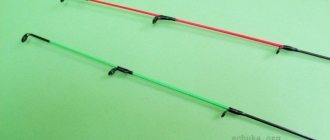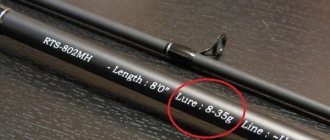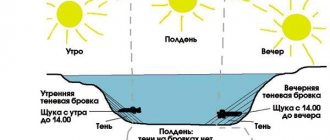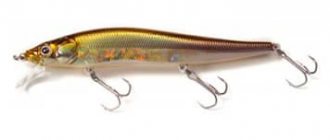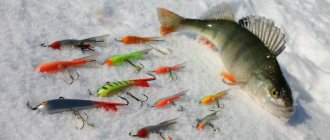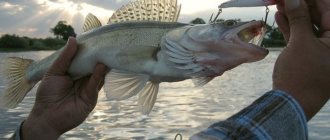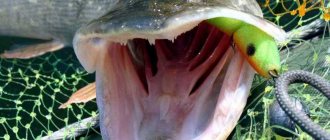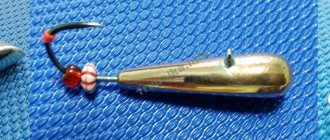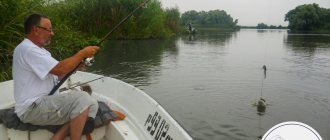Spinning fishing
- this is one of the most effective ways of catching a predator, the goal of which is to outsmart the fish and make it believe that your bait is completely edible and that it is not bait at all, but a real live fish that will not be difficult to grab.
Of course, in order to correctly present bait to the toothy inhabitants of reservoirs, you need to know certain subtleties of this fishing, the predator’s favorite places, depth and time of fishing, be able to select bait depending on the time of day, weather conditions, type of fish and size, as well as other factors. Now we will analyze spinning fishing from all sides, so that you can safely go to the reservoir with a full knowledge of spinning fishing and apply your knowledge in practice.
Content
- 1 What kind of fish to catch
- 2 How to catch correctly
- 3 Where to fish
- 4 When to catch
- 5 Choosing a rod
- 6 Choosing bait 6.1 Choosing a spinner when fishing for pike
- 6.2 Choosing a spinner for pike perch
- 6.3 Choosing a spinner for perch
- 9.1 Wrong choice of gear or its elements
What kind of fish to catch
Fishing with a spinning rod
First you need to decide what kind of fish you are going to catch with a spinning rod. After all, catching each predator has its own nuances, which must be taken into account when searching for promising places, choosing bait and the method of deploying the spoon. You can catch the following types of fish with a spinning rod: pike, perch, pike perch, ruff, catfish, asp, chub, burbot, trout, salmon, etc.
These are the fish that are the most popular objects of spinning fishing, although the lion's share is taken by predators such as pike, perch and pike perch. At least 70% of fishermen who are fond of spinning fish hunt one of these fish or all three at the same time. The leader in this race is pike. This predator is the most coveted trophy of almost any angler. First of all, pike has earned such popularity in spinning fishing due to its fairly large population in reservoirs, both in rivers and still waters. In addition, it has a rather impressive size and tough resistance when playing.
The next one can probably be considered perch. This fish is certainly smaller in size than pike, but due to its large numbers and great gluttony, it is a big fan of many anglers. Besides, if the pike doesn’t bite, you can always switch to perch fishing. If you find a school of perch, you can count on a fairly large catch. And for beginners, perch is a wonderful training ground for learning spinning fishing. Perch is easier to catch than pike. Yes, even simpler tackle will work for it. On perch you can practice casting, retrieving and learn to feel the bottom and bite with bait.
Well, the third most popular fish for spinning fishing is pike perch. Pike perch is a crepuscular predator, so you can start fishing for it after a day of pike or perch fishing, if, of course, you have some strength left. Pike perch, unlike pike, cannot cut the line with its teeth, so when catching it, you don’t need to use a metal leash. But if there is still a possibility of a pike biting, then it is better to be safe.
On the rifts
Fishing on rifts is specific; rift predators clearly divide their spheres of influence among themselves, which has to be taken into account when searching for chub. In principle, this fish gets along well with pike perch, and yet the fanged one is more often found on deep rifts, and the chub prefers shallower ones, where the depths are knee-deep, and, despite this, specimens weighing up to 2 kg can be found in such places. Judging by my practice, at such depths the most effective are shallow-water wobblers (with a depth of up to one and a half meters) with a large amplitude of oscillations, and always with a rattle inside.
How to catch correctly
What does it mean to fish correctly with a spinning rod? Correct fishing is the kind of fishing that brings success. In order for your spinning fishing to be successful, you need to know, be able to and follow some of its rules. You must be able to cast, choose a spot, cast the spoon correctly and select the bait. Taken together, this will be correct fishing, because in order to successfully catch you need theoretical knowledge, practice and your own fishing experience. Let's start from the very beginning.
When you arrive at a pond, first of all, look around, choose a promising place for fishing, select bait (we’ll talk about this below) and cast. When casting a spinning rod, you need to reel in the line so that the bait is no further than 1 meter from the tip of the rod, open the bracket on the reel and press the line with your index finger to the rod so that the line does not unravel. Swing the rod, moving it behind your head and cast with a smooth and at the same time sharp movement. We release the finger that holds the fishing line when the angle between the rod and the surface of the water is about 45°.
Wait until the bait sinks to the bottom and begin to rotate the reel handle, periodically twitching the rod tip in order to give the bait additional impulses. Try not to rush, let the bait sink to the bottom again and again and then, by rotating the reel or jerking the rod, tear it away from it. Try to repeat the movements of the small fish as accurately as possible, then the predator will definitely bite.
First fish one promising place, making 5 casts in different directions - left, center and right, and move on to another. If there are no bites, change the bait or its color. Sometimes, in search of bites, you have to travel long distances along the shore and sort through a huge number of baits of different shapes and colors.
What are the stages of the process?
When a decision has been made about the intended catch and the equipment has been assembled, you can move on to other stages of the fishing process:
- Choosing a fishing spot.
- Practicing and experimenting with casting and wiring techniques.
- Wrestling a trophy.
Let's look at each of them in more detail.
Finding a cool place
The predator’s favorite areas of water bodies are secluded places from where they can suddenly attack future food.
Such places include:
- eyebrows;
- sharp falls;
- potholes;
- among the snags;
- near deep holes;
- among aquatic vegetation;
- cliffs;
- at a fast pace.
But it is important to understand that the process of searching and hunting for food supply differs for each predator:
- Pike is a solitary individual. Attacks suddenly from an ambush.
- Perch is a schooling fish. Hunts as part of a pack. Therefore, if you managed to catch a perch, then you need to try to continue casting in these places. Great chance to catch a few more of his relatives.
- Zander. Hunts exclusively at night as part of a pack.
Spinning fishing is considered active fishing because the angler often has to fish large areas of the coastline in search of a worthwhile trophy. The process is simplified when the fisherman is familiar with the bottom topography. In new places you will have to experiment a little. Stepped jigging, where the bait is replaced with a sinker, helps to quickly determine the bottom topography.
How to do wiring correctly
The main goal of any wiring is to ensure the most natural behavior of the bait in the water, so that the predator has the desire to attack. The following types of postings are most popular among fishermen:
- Uniform. Suitable baits are edible silicone and a spinner. No experience required, so suitable for beginners. The fishing line or thread is wound evenly onto the reel. When reeling slowly, the bait will go closer to the bottom and rise to the surface with increasing speed.
- Stepped. It got this name due to the fact that the bait sinks to the bottom and then rises sharply up. It is precisely at the moment of rising from the bottom that the predator usually tries to attack.
- Uneven. The optimal bait is a spinner spoon, but other types are also allowed. The idea is to use different winding speeds and alternate with pauses. Suitable for experienced fishermen, since you need to be able to choose the right sequence of such alternation.
- Twitching or jerk wiring. Here you can play jerkily, both from side to side, and make depth changes. The bait is a wobbler. A rod with a powerful blank. The fishing line is braided. Requires experience from the fisherman.
- Jig. The bait is edible silicone of any type, equipped with a jig head. The fishing line is braided, monofilament. Refers to a type of stepped wiring. Only the coil works here. The winding speed and pause duration are adjustable.
Beginners need to start with uniform wiring, gradually moving on to other techniques.
Fishing
Involves timely hooking and safe removal of the predator from the water. Often fishermen confuse bites with elementary hooks, especially if fishing on a pond is the first time. It is important not to make sudden jerks, but to carefully try to save the bait.
If you are sure that it is a predator responding, then it is better to give it a couple of seconds so that it more reliably swallows the bait with a hook. Hooking a large predatory specimen is done with smooth movements so that the fishing line does not break due to a sudden load. Gradual movements towards the shore will exhaust the future trophy, the jerks will not be so strong.
When directing your catch, you must not forget about possible obstacles along the way and try to avoid them. With the clutch adjusted correctly, the winding of the line is progressively stopped. When the fish is already near the shore or near the boat, you should arm yourself with a landing net and put the catch in it. You should not remove the hook from the predator’s mouth with your bare hands. It is much safer to use a special yawner.
Where to fish
The success of spinning fishing can depend on many factors, one of them is the ability to correctly identify a promising place. You can walk along a pond all day, casting with a spinning rod over and over again and not see a single bite, or you can pull out the first specimen after just a few casts. It all depends on whether you know where the fish might be or not. Let's look at which parts of the river you should pay attention to first.
If there are areas on the river with the presence of reeds along the bank, then it would be better to start fishing from such a place. If you have a boat, then it’s great for spinning fishing! Well, if there is no boat, then fishing by casting along the reeds will be more difficult; you will have to either go into the water or choose such places on the bend of the river so that it is convenient to cast from the shore along the reeds.
So, having found a suitable place, we must examine it for the presence of fish and its activity. First, you need to make several casts upstream so that the current carries the bait towards you. We make the first cast as close as possible to the reeds, about 0.5 m from it. Swing the lure over the top to check if the fish are in the upper layers of the water. If there is no bite, cast again, just move the bait closer to the bottom. We make the next cast further from the reeds and repeat everything exactly the same as with the first two casts, only at a distance of 1-2 m from the reeds. Well, then - two more similar casts, only at an even greater distance from the reeds.
Then we change the casting direction and throw the spoon downstream. Please note that the wiring will now be carried out against the current, which means the spoon will sink more slowly. The coil rotates against the current at a lower speed. We repeat the casts in exactly the same way as against the current - near the very line of the reeds, and then further and further. If there are no bites, try changing the bait or the wiring method - maybe your wiring is too fast or, on the contrary, slow. Or maybe the fish just don’t like your bait, its color or size.
If you want to fish a place effectively, but as quickly as possible, divide the fishing area into 5 vectors - in the center, left, right along the reed line and 2 diagonally. The predator can also be found near snags and trees submerged in water. Only here you should be extremely careful, otherwise you can leave all your bait in these snags. If you are just learning to fish, it is better to cast away from such places - no closer than 5-10 meters. If the water is fairly clear, the fish will still notice your bait. And a beginner, even without snags, will lose some of his baits - either he will get caught in a tree above his head, or he will forget to open the clamp on the reel...
Also, when searching for a predator, pay attention to splashes in the water.
Powerful blows of the tail on the water may indicate the hunt of a pike or other large predator, and fry scattering in all directions may indicate that they are being chased by a perch, chub, asp or the same pike. Sometimes, a pike even jumps onto the shore in pursuit of its prey, and then slowly rolls back into the water. This usually happens on the other bank from the fisherman, so all that remains is to watch and drool. So, always try to cast into such visible places of predator activity. There is a high probability that he will take your bait, and not the fry. Fishing with a spinning rod
Also, a predator, especially a large one, loves reliable shelters, which can serve as deep holes and slopes. In such places you can catch really large pike, pike perch or catfish. A bridge over the river might be a good place. Predators often like to hang around its piles. And of course, on large rivers such as the Volga, Amur, Dnieper and similar ones, it is practically impossible to do without a boat and an echo sounder. On such rivers, in order to catch a predator, it is very important to find a deep hole, in which pike, pike perch, catfish, large perch and others are often caught. Sometimes, in search of fish on small rivers, you will have to travel a long distance with a spinning rod, but this is the beauty of this type of fishing.
Interesting tests
Logic and logical thinking test
You'll have to strain your brain.
Attention and memory test
There are a lot of trick questions in this test!
Animal knowledge test
Guess what animal is in the photo?
Test for knowledge of phraseological units
Evaluate the richness of your speech by taking a test on your knowledge of phraseological units.
When to catch
The predator can be caught using a spinning rod throughout the entire period of open water. The richest seasons for catch are spring and autumn. In the spring, the fish have a pre-spawning feast and if you go fishing during this period, the fishing can be very successful. True, every year this time can shift depending on the water temperature and weather conditions, so no one can accurately say the date of the “mad bite”. Here, whoever guessed right is lucky. In any case, this happens from the moment the ice begins to leave the water until it completely disappears.
In the fall, an intensified hunt for predators also begins, because the pike begins to eat again. In the fall, she throws herself at everything in order to accumulate fat for the winter and survive until spring. This period can also last only 1-2 weeks, and when it begins and ends is also unknown, so in the fall it is worth paying more attention to catching predators and going to the reservoir more often so as not to miss the bait.
It is also worth taking into account the fishing period when fishing promising places. If you are fishing during the spring or even autumn feeding season, then you should not linger in one place. In this case, a more rational solution would be to fish as large an area as possible. After all, the predator in such periods is the least picky and if there is one, it can take any bait and retrieve. Don't waste time - move on.
It’s another matter when the predator is already more cautious, begins to sort through the baits and does not want to chase the bait with the wrong wiring. Then it’s worth paying maximum attention to promising places and fishing for them with different baits and fishing methods. It happens that a predator reacts to the bait only from the 30th cast, although it would seem that there is no one at this point, but changing the wiring and bait yielded results.
What baits are used
A wide selection of baits made from artificial materials are available for sale at different prices. The best option is a product from a trusted manufacturer with strong fittings and good color coverage. Selection is carried out according to the type of fishing, rod, expected size of prey.
Artificial products are divided into 3 types:
- Wobblers. The main raw material is polymer. Appearance: imitation of a small fish. They have a unique game. High catchability. Depending on the set of properties, they have their own classification (shads, minnows, poppers, walkers and others). They require the fisherman to have knowledge of different fishing techniques. Beginners need to start with something simpler. Used for twitching and trolling.
- Spoons. In the classic version there are rotating and oscillating. They are purchased strictly for a specific type of fish. Modern modifications are produced - spinnerbaits, castmasters. Can even be used for winter fishing.
- Silicone. From this raw material, imitation worms and various insects (twisters, vibrohosts, slugs and others) are produced. Choice of colors. They are inexpensive. But the service life is limited. Edible silicone is considered more effective, since fish are attracted not only by appearance, game, but also by smell. An excellent start for practicing wiring for beginners.
But if a predator is reluctant to respond to artificial bait, then one should not forget about bait of animal origin - dung worms, maggots, grasshoppers.
Rod selection
The first step towards mastering the art of fishing with a spinning rod is choosing the appropriate rod. Effective fishing with a spinning rod is largely determined by what form (rod) this process is carried out. The type of bait, wiring technique, conditions under which the predator is caught are factors influencing the choice of spinning tackle.
- Fishing with loaded soft (silicone) baits, coupled with stepwise retrieving and tapping the bottom of the reservoir, involves the use of jig tackle. In this case, the weight of the bait itself directly affects the characteristics of the spinning rod. This “tool” is used to catch pike, perch, pike perch and other freshwater predators near the bottom of the reservoir.
- Ultralight tackle is designed for catching predators and some types of “peaceful” fish (using edible silicone) using ultralight baits. They can weigh less than one gram and up to seven or eight.
- Twitching gear is used mainly for catching the toothy robber - pike. Rods of this type are designed for jerking baits of the “wobbler” category.
- Casting tackle is designed for fishing with baitcasting reels (the rod handle is equipped with a special protrusion for controlling the fishing line with your finger while retrieving the bait) and has some versatility - it is successfully used for jigging and twitching.
- Trolling is a type of powerful spinning gear that is fixed on board the boat. Such gear is used to catch a large predator, for example, a 200-kilogram tuna somewhere in the Atlantic. The movement of the bait is given by a moving boat, and the predator is provoked to play with it. However, pike and pike perch are also caught by trolling on large rivers.
As part of the answer to the question of how to choose a spinning rod for a novice fisherman, when purchasing it, you need to pay attention to the following main characteristics:
- Test. This value in the form of two numbers on the form shows what total weight of baits with equipment should be used by a spinning angler in relation to a specific fishing rod. Let's say you bought a spinning rod with a test weight of 5 - 20 g. This set of numbers indicates that you should use light bait. Otherwise, the rod may break when casting.
- Length. The value of this characteristic is determined by the conditions of the upcoming hunt for a predator, as well as the distance over which it is planned to throw the bait. Fishing from a watercraft (boat) or from the shore on small rivers involves the use of a short form (1.9 - 2.1 m). Casting over long distances or vegetation that interferes with fishing along the shore of a reservoir requires rods with a length of 2.7 - 3.0 m. Beginner spinning players are recommended to choose rods with a length of 2.1 - 2.4 m.
- Build a rod. This characteristic determines the flexibility of the spinning rod. The option when, when the rod is bent, its upper part is first deformed, shows that the spinning rod has a fast action. The bend in the middle is medium tuning. Uniform distribution of deformation throughout the rod - slow action. Knowing this information will help you choose a spinning tackle for catching a predator for the required bait, taking into account the casting distance. Beginners in spinning fishing are advised to opt for a rod with a medium action.
How to choose a spinning rod?
When choosing fishing accessories, you need to remember that there is no universal spinning rod.
Some rods are given the term “universal”, however, specialized ones have always been considered more convenient. When choosing this type of fishing tackle, you should strive to ensure that the spinning rod is:
- It was of high quality and was not any kind of falsification. You should buy it from a good, trustworthy store. Its price cannot be cheap.
- Easy. If the weight of a product exceeds three hundred grams, it is not very convenient to use, its characteristics become worse.
- Comfortable. The rod should fit comfortably in your hand. You should install the reel right in the store and see what the weight distribution will be and how convenient it is to control. There you should also evaluate how high-quality the rod handle is.
- Required size. When used on a small river, the length of the rod can be about two meters. Long casts and jigging are best done when the length is more than 2.7 meters. A length of 2.4 to 2.6 meters is considered universal.
- With good sensitivity. The better the sensitivity of the rod, the more convenient it is to fish.
- With the right test. It is better to choose a product that has a wider test for the lower weight range, for example, 5-25 grams. In this case, you can experiment with different baits, learn to exercise proper control over them, and use tackle when fishing in a variety of situations.
- With the right structure. Many people prefer gear with a fast action for beginners. Although this limits the weight of the bait and prey, it allows for much more effective control of the bait.
Bait selection
Building a spinning rod
The choice of bait for spinning fishing is very important and should be approached with the utmost seriousness. If you have the means, it is advisable to buy bait from well-known brands: Salmo, Yo-Zuri, Rapala, etc.
Fishing with such baits can be many times more effective, because cheap Chinese copies can have a completely different game, which greatly affects the bite. Expensive, proven baits do their job excellently, but not everyone is ready to spend good money on such “consumable” material, which every now and then breaks, breaks or gets lost.
If your goal is to catch pike, then choose a lure for pike. If you are not ready for such expenses, start with inexpensive baits such as twisters or cheap Chinese spoons and wobblers. Sometimes you come across quite successful models that work great when catching predators with a spinning rod. However, it is almost impossible to guess whether a given copy will work. It is better to stock up on such baits in large quantities so that you can always choose the most effective ones.
There are, of course, high-quality copies that are much cheaper than their branded counterparts, but they work just as well. According to the advice of experienced spinners, you can go fishing successfully by taking with you such relatively inexpensive lures as: silver stream, typhoon, tsunami; Strike Pro.
Of course it will do for a start, but don’t forget that a copy of a BMW will forever remain just a copy; of course it will drive, but it won’t be possible to achieve the same quality. When choosing bait, you should also take into account weather conditions and the fishing period. Let’s say if the weather is cloudy, then to catch a predator it is best to choose a copper or brass colored spoon. A dull spinner works better in cloudy weather. But in sunny weather, it is best to use a silver spoon, which will sparkle in the sun, reflecting sparkles of sunlight in all directions, thereby attracting a predator and making him think that this effect is created by the scales of a fish. The reflection of a spinner sometimes plays a decisive role when fishing with a spinning rod and can determine the outcome of the fishing.
Also keep in mind that if fishing is carried out during the pre-spawning period, then the predator, due to its belly full of caviar, simply will not chase the large bait. But during the autumn feeding period, on the contrary, pike can be caught simply with huge spoons.
And of course, the choice of bait directly depends on the fish you are going to catch.
Choosing a spinner when fishing for pike
Pike is a truly formidable predator of any body of water; to catch it, you can use any type of bait, be it a twister, spoon, spinner, wobbler or something else. The choice of bait very often depends on the reservoir, because there are reservoirs where pike take excellent bait with various oscillating spoons, and there are those in which it has never pecked at them. Therefore, a new, unexplored body of water should first be fished with all types of bait in order to determine the working one. Many anglers use wobblers exclusively to catch pike. Well, this is not surprising, because a properly selected wobbler works on almost any body of water and in any weather. And if there are more than a dozen of these wobblers in your arsenal, then it’s only a matter of time to find a working one.
Choosing a spinner for pike perch
Pike perch can also be caught using various types of bait. Pike perch is caught very well with jigs, so a twister is one of the most suitable baits for catching it. Also, you should know that when catching pike perch with a spinner, you should choose driven spinners of a narrow, oblong shape, reminiscent of bleak. The fact is that the structure of the pike perch’s mouth does not allow it to hunt wide fish, such as crucian carp, but bleak is quite suitable.
Choosing a spinner for perch
Perch is excellently caught using a twister and a spinner. Fishing with a spinner is not only very effective, it is also great for training for beginning spinners, since its game consists of simply rotating the reel at different speeds. After all, in order to appreciate fishing with a spinning rod, you need to experience this delight of biting and retrieving a predator. Spinners of various shapes and colors - start with them.
Choosing a fishing spot
Fishing with a spinning rod
The fisherman's familiarity with the body of water is essential for successful fishing. The advantage of such a spinning player who has learned the reservoir is obvious. Knowing at what point in a river or lake there are holes, sunken snags and sinkholes, having learned to set the boundaries of riffles, with stones at the very bottom, etc., an experienced spinning fisher will more reliably establish where the fish are at a given time, as well as what kind of bait can be expected to bite .
A depth gauge is an indispensable aid when familiarizing yourself with a body of water. When choosing a fishing location, you should not abuse long journeys to hard-to-reach points tens of kilometers from home. Sometimes unforgettable fishing awaits literally nearby. The most advisable thing is to go to a small pond or to the nearest river - such reservoirs are necessarily located in natural proximity to populated areas and are populated, as a rule, by pike and perch. Before draining water into a riffle, the fish, as a rule, stands two to three meters above its beginning, as a result of which it is necessary to throw here so that the spoon, carried by the current and dragged by reeling, passes at a certain distance from the beginning of the riffle or, 2- 4 meters from its border.
In the summer, when fishing from a boat, it is sometimes more profitable to cast from the middle of the lake to the shore, and also to carry the spoon through the thickets, slightly speeding up the reeling. The treasured spots for spinning anglers are located near the dam in the reservoir: here fishing is done both above and below the spillway. Often, the bottom in such places is replete with sunken logs and snags. It is clear that in such inaccessible places, as a rule, pike are found. It is located here away from the main stream (which is formed from the fall of water), in lulls and backwaters. Along with pike, you can also catch large perch in this place. Pike perch is also found in similar “strong” places, but it is located slightly below the fall of water from the dam, on weakening streams. At the surface there is usually asp, and near the bottom, chub and also ide are caught. Mining in such places can be extraordinary. Particularly attractive fishing spots are dams on large rivers. Here you can expect exceptional, exciting fishing. It is possible to catch pike perch, pike perch, catfish, and perch.
Fishing in lakes can also be done near steep shores, in deep holes, near sunken trees, near reeds or grass. If there is a relatively long ridge or some kind of elevation in the reservoir, then it is necessary to move the spoon so that it passes across this ridge, or diagonally, but not along it. When fishing in reservoirs formed from the construction of dams on rivers, it is not necessary to move the spoon along the bottom of the flooded riverbed. It is much better to fish by throwing the lure across, grabbing both banks with a wire, or try to guide it along the slopes of the reservoir bed. If a good place for fishing has formed in a large closed reservoir, then it must be marked with some landmarks, certainly writing them down, so that during secondary fishing it will be faster, the main thing is to find it accurately. If a given body of water is rarely visited by other fishermen, then the fishing spot can be marked with a floating buoy or other object.
In general, you should catch any body of water that is “suspicious” of fish, a river, a pond, a lake, an abandoned peat quarry or a pit near old, abandoned factories. Sometimes, quite suddenly, in such reservoirs you catch quite a few large perches and pikes. One should not neglect small but deep bays, often found along the banks of large bodies of water. It happened that a considerable pike was caught in them. Fishing in shallow places and sandbanks is practically useless. Only pike perch will enter small sandbanks in search of food during the dense night, although its presence in this place depends on small fish and the presence of a current.
Tactics and techniques of spinning fishing from the shore
To successfully fish from the shore, you first need to find a fishing spot. Among fishermen there are some rules on this topic:
- in a deep body of water, prey should be looked for in a shallow place, and in a shallow body of water - where it is deep;
- on a wide river it is faster to find fish in narrow channels, there is more food there;
- the catchable area must stand out with something; there will be no food on a clean bottom;
- if the shore is clean, without vegetation, then there will be no bite here.
In fact, when fishing in an unfamiliar place, it is advisable to talk with local fishermen and ask them about the presence of holes, pools, and dams. Coastal washouts and small bays will always be of interest to fishermen. The current here is weak and a lot of food accumulates. But you need to know that the fish stands on the border of the currents - direct and reverse - where it forms a whirlpool.
In heavily overgrown areas, prey should be sought at the border of clear water and vegetation. In the spring, when it rains, fish gather at the confluence of clear and muddy water. If the river is small, then it is better to cast from the slope of the bank under the steep one. Fishing can be successful at a bend in the river, where the bank has been washed away and a whirlpool has formed. There is also a good bite near piers and sunken barges.
Methods of posting baits
The main fishing methods, without which spinning fishing will not bring the expected result:
- Uniform wiring. After casting and sinking the bait to the bottom, the line should be slowly reeled in. This method is effective using any type of bait - it’s just sometimes necessary to slightly increase the rotation speed of the spinning reel or, conversely, slow it down.
- Wobblers are effective for twitching - after the bait reaches a given depth, a short, strong jerk is made with the tip of the rod. During the pause, the slack in the fishing line is removed. This movement should be brought to automaticity.
- Jig wiring involves the use of soft baits made of silicone and foam rubber. Underwater it looks like this - the bait either rises up or drops sharply to the bottom. That is, stepwise wiring is carried out. The speed at which the bait makes these movements affects which fish will bite it. For example, a pike will definitely react to a smooth fall of the bait and an energetic rise, which is set by 1 - 2 revolutions of the reel.
Tips and common mistakes
- Try to constantly change the nature of the action of the bait when moving in steps, this will allow you to achieve a better result.
- Often, a sharp hook is absolutely unnecessary; it only leads to a tear in the fish’s lip. Try not to hook at all when fishing with a wobbler. The pike will hook onto the tee well anyway.
- Many beginners overtighten the drag on the reel. Experience shows that it is better to under-tighten than to over-tighten.
- The mistake of beginners is that, having made a hook, they immediately suddenly rush to rotate the reel. First you should feel how the prey will behave, and then, without fuss, act.
- Consult more with experienced fishermen, study fishing forums and good luck will certainly come to you.
Wrong choice of gear or its elements
Fishing with a spinning rod from the shore
Let's start with the fact that the tackle may simply not correspond to the conditions in which fishing takes place. Beginner fishermen may choose gear that is too powerful, or, conversely, not strong enough. Or it may happen that some of the equipment elements do not fit into the overall picture. It’s one thing if, when fishing with a thin line, you catch a large fish and the line breaks, and quite another if the hook is chosen incorrectly and does not match either the other gear or the expected size of the trophy. A small hook does not penetrate the mouth of a predatory fish. therefore, there is a high risk that at the moment of fishing, a precariously sitting fish will come off it. A blunt hook will lead to the same outcome. Again, the other extreme is that a large hook, used for no particular reason, will punch too large a hole in the fish’s mouth and if you give just a little slack, the fish will immediately take advantage of this and leave.
In general, choosing a hook is an extremely important undertaking. To avoid unnecessary fish loss, you may want to give preference to single hooks. Of course, double and triple hooks have their advantage - they are more effective when hooking, but single hooks hold fish better.
The choice of fishing line is also important; the fishing result often depends just as much on it. If we consider fishing for pike perch from the shore, then the conditions that influence the result include the depth and strength of the current. Taking into account the factors that the fishing spot is quite deep and the current is strong, one might say that a monofilament line is completely unsuitable in this situation, since it has great stretchability and because of this, hooking will usually be done late, which is most often provokes the gathering of fish at the very beginning of fishing.
This same fishing line is not suitable even if fishing is carried out at a long distance; in such conditions, high-quality hooking is simply impossible. But in these situations, “braid” is suitable for successful fishing, but you need to take into account that the pike perch has a rather hard mouth, while, for example, the perch does not have the same mouth, and the lips are very delicate. When using braid in such circumstances, the fish may escape due to the lips being torn. Therefore, a certain balance must be maintained between the rigidity of the rod, the line and the adjustment of the reel. but it is impossible to give universal advice here.
Incorrect use of gear
When preparing fishing gear, there are no trifles, so special attention should be paid to the accessories: swivels, fasteners, leashes - all these are extremely important elements of the equipment. And if anglers try to save money on them, then even a good rod, a powerful reel and a thick line will not save the situation.
For example, the drag is the element of the reel that helps preserve the catch. With its help, the lack of elasticity of the “braid” and the excessive rigidity of the spinning rod are compensated if we catch fish with weak lips. The drag helps to tire the fish when the tackle does not have enough power for forceful fishing, but this does not mean that it should always be weakened. The fisherman must certainly take into account a number of conditions: this is the desired object of fishing, the fishing conditions, and the characteristics of the equipment.
Incorrect actions of the fisherman at the time of fishing
The most common mistake made by fishermen is their desire to quickly get their catch out of the water onto the shore or into a boat. When fishing, some people move backwards, deeper into the shore; such an action does not make any sense. It must be remembered that spinning fishing involves not only working with a reel, but also working with a rod, although the head should work first. Some fishermen turn fishing into a tug-of-war competition; you need to be able to correctly assess the situation, otherwise the fish will get off the hook.
The fish itself constantly strives to free itself; the fisherman’s task is to unravel the maneuver and effectively prevent it. The most popular fish technique is the “candle”; the meaning of this trick is that the fish jumps out of the water and tries to jump off the hook, shaking its head desperately. It is better not to allow this, because it is impossible to influence anything while the fish is in the air. But it can be prevented: do not let the fish rise to the surface, at the first sign that the fish is going to the surface, lower the rod down, you may even have to lower it under water.
Some fish use the following technique: they lull your vigilance by pulling you into the depths, and then unexpectedly turn around and come at you, at this moment a slack is formed and an escape is most likely. The angler's job is to pick up the slack to regain control of the fish.
Another fish trick is that the fish goes under the boat, here the spinner is faced with double grief: the rod breaks and the trophy comes off. To prevent such a situation, you also need to lower the rod into the water so that the equipment elements do not catch on the oars or the bottom of the boat, while it is necessary to control the tension of the fishing line to prevent slack, use the friction clutch.
Main selection criteria
The shorter the length, the shorter the casting distance. At the same time, the shorter the spinning rod, the more sensitive it is and the more convenient it is to use.
Thus, when choosing a spinning rod, the main criteria can be highlighted:
- length;
- material;
- system;
- test and power;
- type of rings;
- specifics of fastening the reel and handle;
- type or type of structure;
The length can vary from one and a half to four meters. Everything will depend on the specifics of fishing and the possibility of using the boat.
For long casts, fishing in strong currents and significant depths, the use of a heavy spoon is required. It is necessary to ensure that the weight of the bait matches the weight of the rod.
The test refers to the range of attachment weights that can be used for a particular model. A test of 7 - 30 grams will mean that the smallest mass of the bait that can be felt when casting will be 7 grams.
The maximum upper level is 30 grams. With a heavier bait, the tackle may fail.
Usually the classification of fishing rods is as follows:
- Heavy class , with bait weight from fifteen to sixty grams.
- Middle class , from seven to thirty.
- Easy class , from three to fifteen.
- Ultra-light , from one to seven grams.
The power rating of the product is influenced by its thickness at the bottom, and the test is influenced by the thickness at the top. Significant power and light test can be balanced only with a long rod length.
The power of the spinning rod determines the size of the fishing line used. A fishing line that is too strong can lead to the rod breaking in the event of a sharp hook or snag.
Action is understood as a characteristic of a spinning rod that affects the short-term response when the load increases.
Fast action makes the spinning rod more sensitive. Recently, the plug rod has been gradually replacing the telescopic rod, surpassing it in all characteristics.
Fishing rods are distinguished by their structure:
- slow;
- average;
- fast;
- superfast;
It is determined by the bend of the rod under load. Slow action allows the rod to bend equally over its entire length in the form of a parabola. With a fast system, only the upper section is bent.
The action is influenced by the geometry of the whip and the rigidity of the materials used. Fast action is ensured by large taper values and wall thicknesses, as well as increased material rigidity.
The advantages of slow construction include:
- Improved shock absorption when fishing for prey.
- Reduced sharpness when casting, which helps baitfish survive.
- Improving the throwing distance indicator.
Of the materials used for the manufacture of fishing rods: fiberglass and carbon fiber (carbon), the latter is preferred in many respects.
Bypass rings can be ceramic, silicon carbide and aluminum oxide. Silicon carbide rings are the most reliable.
For the spinning rod handle, microporous rubber or natural cork is used. The latter is less susceptible to contamination and more convenient.
